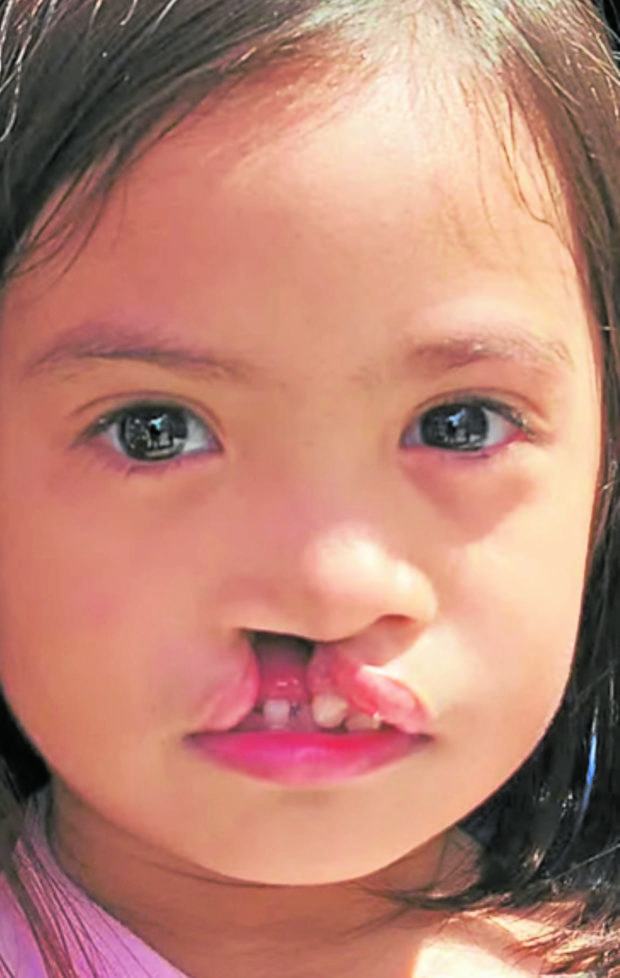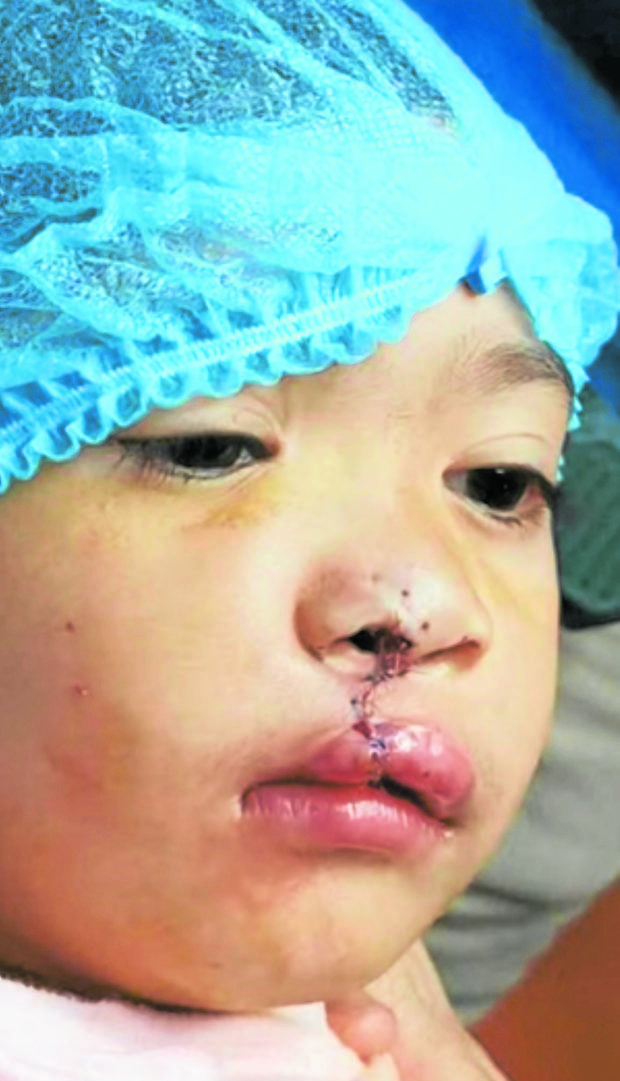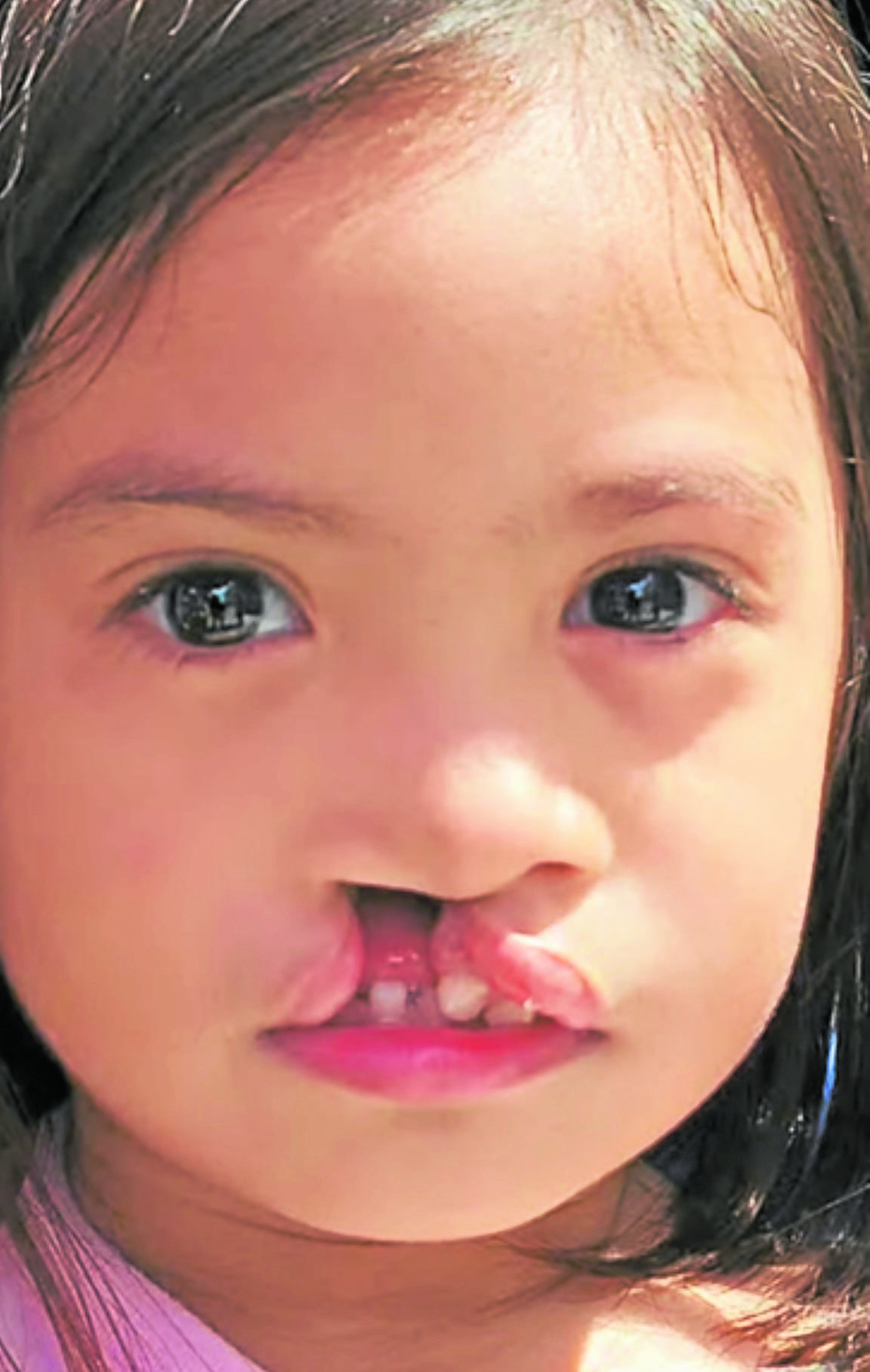
Three-year-old Lucy (not her real name) was born with a cleft lip, known locally as bingot. Because of the gap in her upper lip extending to her nose, she had difficulty in feeding, and food would regurgitate out.
Lucy was also starting to show signs of an inferiority complex. She had a pretty face with a pair of expressive eyes, but she was becoming conscious about the cleft in her lips and somewhat twisted nose.
Her parents tried their best to have Lucy’s inborn defect corrected, but still could not afford the nominal cost of the surgical repair needed even in government hospitals. Then they heard that Hospital on Wheels (HOW), a regular-sized bus converted into a modern operating room, was coming to their place for a surgical-medical mission.
Lucy’s mother thought initially they might just end up being frustrated at not being accommodated due to the stringent requirements, similar to what they encountered previously. But to their surprise, after a quick evaluation by the surgical team headed by HOW founder Dr. Jim Sanchez, Lucy and her mother were welcomed into the bus. After an hour or so, her cleft lip and nasal deformity were masterfully repaired. They didn’t have to spend a single peso.
You may watch Lucy’s fascinating transformation inside the modern bus-operating room at youtu.be/3q2nuPPjbWY. She underwent the surgery fully awake. Her nerves in the operative site were just numbed with a local anesthetic. Throughout the hour-long surgery, she never flinched or showed any indication of pain or fear.
Unheard of
A full surgical repair of a cleft lip and nasal deformity in a 3 year old under local anesthesia? Fully awake and no pain experienced the whole time? This was previously unheard of. A surgeon who says he could do this would have been accused of pure braggadocio. But Dr. Jim and his HOW team have been doing this for quite some time now, mostly for their charity patients.
This innovative technique markedly reduces the cost of surgery, and the patients could go home soon after. Many of the surgeries they do inside the HOW would have been usually done under general anesthesia (GA) in a regular hospital setting. With GA, the patient is usually put to sleep, a tube inserted into their airways to deliver the anesthetic and help them breath while under anesthesia. They have to be observed and monitored until they fully wake up from the anesthesia and for several hours more to check for possible complications.
Under a skillful application of local anesthetic, the surgical procedure for various indications is significantly simplified, and with the thousands of cases Dr. Jim and his team have in their records, not a single serious adverse event has been reported. Even their foreign counterparts are impressed, such that they have been invited to share their technique in their medical conferences.
In October, Dr. Domingo Alvear and Dr. Beda Espineda, members of Dr. Jim’s surgical team, will present their local experience on how to do hernia repair in children under local anesthesia at the American College of Surgeons annual convention. They have already done more than 400 of this type of surgery in children.
For many indigent patients who almost lost hope that their surgical problem would ever be remedied, the HOW bus is their symbol of hope. Some would say it seems to radiate magic. This is probably the reason why many indigent patients are in tears when they see the bus coming nearer, and quite a number love to take selfies inside and outside of it. God has indeed provided the HOW and Dr. Jim’s team as a symbol of hope for the poor.
Some describe it as an extraordinary bus that carries out their wishes for their bingot and hernias being repaired or their big masses excised, in expert hands and all for free. That seems too good to be true, but we see it as part of God’s providence for the least of our brethren.
Sharing his technique
People have suggested to Dr. Jim that he should have his surgical technique patented, so he could at least get the credit for it, even just for posterity. But he brushes these suggestions aside, and simply replies that all he wants is to share his technique so many patients around the world could benefit from it, especially in underdeveloped and developing countries.
“Sayang ang knowledge and experience na natutunan ko kung hindi ko maipapasa sa iba (My knowledge and experience will go to waste if I could not share it with others),” he says.
Dr. Jim has pioneered and mastered the numbing of the major branches of the nerves in the head and face as they exit from their foramens or openings in the skull. This is done simply by injecting a local anesthetic to block these nerves. He has also learned to block the nerves in the neck area, and he has been sharing for free instructional videos detailing how to carry out his technique. Surgeons, anesthesiologists and others can learn from it.

During the HOW mission in Pangasinan recently, Dr. Jim taught two surgical residents from the Armed Forces of the Philippines Medical Center hernia repair under simple nerve blocks. He also shared the techniques he developed in hernia repair and other surgeries with surgical colleagues. The Department of Surgery of the AFP Medical Center is now conducting research to validate the advantages and benefits from his innovative techniques.
According to Dr. Jim, simple nerve blocks also work well for upper and lower extremity surgeries, including amputations. ”If it can be done on small children with cleft lip or hernia, how much more on adult patients?” says Dr. Jim.
He believes that the government can save a lot of money in hospitals with the use of nerve blocks for their surgeries. He cites that cleft lip or hernia repair would cost at least P25,000 in government hospitals, at least three times more in private hospitals. At HOW, the needed surgical supplies and medicines cost less than P5,000 per patient, but patients don’t pay anything because everything is shouldered by good Samaritans.
Dr. Jim’s HOW is a nonprofit, nonpolitical, nonreligious volunteer-initiated organization, whose main goal is to bring the hospital close to the community. In a previous column, we compared it to the metaphor of the mountain coming to Mohammad.
The concept arose from Dr. Jim’s more than three decades of volunteering in surgical missions. Realizing the inaccessibility of surgical facilities, and specialists in certain areas, the HOW was formed in 2007, and has since conducted almost weekly medical missions in various parts of the country, particularly in calamity-stricken areas.
Every mission day, they spend at least P300,000—half of which is subsidized by Friends Who Care, and the other half by other donors. Although mission expenses have increased so much with increase in the number of indigent patients requiring help, God has always provided through kind donors, and the HOW has not stopped rolling for its regular missions.
3Ts
Dr. Jim’s fellow graduates from the University of Santo Tomas Faculty of Medicine and Surgery, particularly his batch (Class 1980), and his brods in the Tau Mu Sigma Phi Fraternity have been conducting fundraising campaigns to help the HOW missions.
“Anyone with any of the 3Ts (time, talent and treasure) can join or help HOW,” enjoins Dr. Jim. ”Together, we will be able to help thousands who are unable to access or afford surgical and medical care.”
On a regular mission, his team usually consists of eight to 10 surgeons and 16-20 supporting staff, all rendering their services for free. In Pangasinan recently, they stayed for three days and operated on 523 indigent patients with various surgical conditions (skin and soft tissue tumors, hernia, cleft lip, goiters, breast and parotid masses including cancerous tumors, resection and reconstruction of skin cancers, etc.)
They also had a busy day last weekend in Rodriguez, Rizal. Their forthcoming missions will take them to Mabalacat, Pampanga (April 29-30), Pasay City (May 7), Mandaluyong City (May 21), and Infanta, Quezon (June 3-6).
For those who may wish to avail of the charitable services of Dr. Jim and his fellow “angels,” you may call tel. no. (0930) 818-1467, (0918) 937-7415, or leave a message on their FB page: Hospital On Wheels Philippines.
Those who wish to help the HOW with their kind donation, or to volunteer their services, may also do the same. Even “angels” can use some help.









































